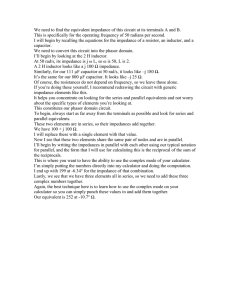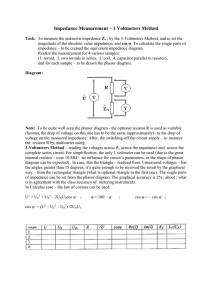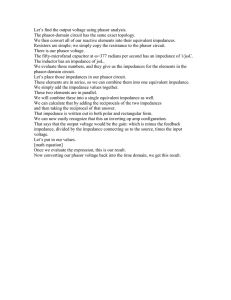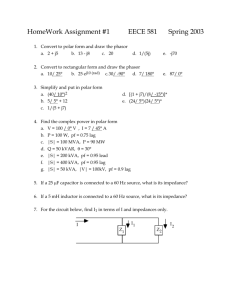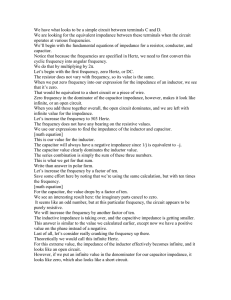Sinusoidal Steady State Response: Frequency domain representation Impedance
advertisement
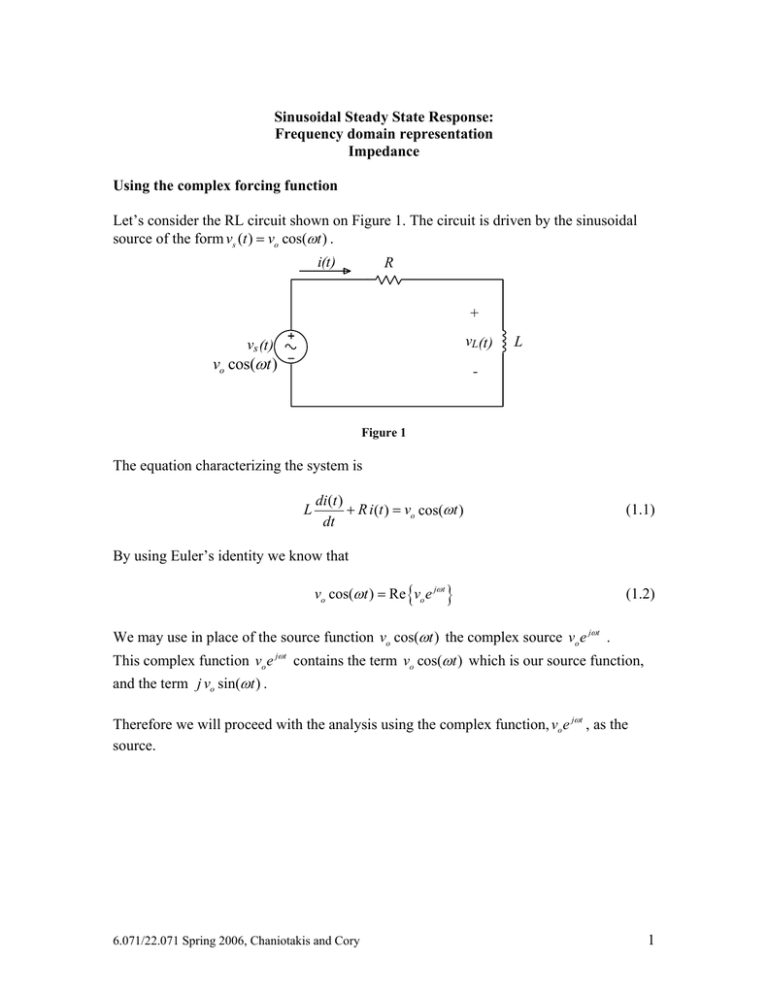
Sinusoidal Steady State Response:
Frequency domain representation
Impedance
Using the complex forcing function
Let’s consider the RL circuit shown on Figure 1. The circuit is driven by the sinusoidal
source of the form vs (t ) = vo cos(ωt ) .
i(t)
R
+
vL(t)
vs (t)
vo cos(ωt )
L
-
Figure 1
The equation characterizing the system is
L
di (t )
+ R i (t ) = vo cos(ωt )
dt
(1.1)
By using Euler’s identity we know that
vo cos(ωt ) = Re {vo e jωt }
(1.2)
We may use in place of the source function vo cos(ωt ) the complex source vo e jωt .
This complex function vo e jωt contains the term vo cos(ωt ) which is our source function,
and the term j vo sin(ωt ) .
Therefore we will proceed with the analysis using the complex function, vo e jωt , as the
source.
6.071/22.071 Spring 2006, Chaniotakis and Cory
1
Figure 2 shows the same circuit but with the complex source in the place of the source.
(Note that we have used different variables to indicate the response of the circuit to the
complex forcing function.)
I(t)
R
+
VL(t)
Vs = vo e jωt
L
-
Figure 2
The corresponding complex response for the current I(t) is
I (t ) = I o e j (ωt +φ )
(1.3)
and by substituting the complex form for Vs and I(t) into Equation (1.1) we have
L
d
I o e j (ωt +φ ) + I o e j (ωt +φ ) = vo e jωt
dt
(1.4)
which upon simplification becomes
I o e jφ ( R + jω L ) = vo
(1.5)
Equation (1.5) contains the information for both the amplitude I o and the phase φ . By
rearranging Equation (1.5) we have
vo
(1.6)
R + jω L
In order to determine I o and φ we express the right hand side of Equation (1.6) in polar
coordinates
I o e jφ =
I o e jφ =
=
vo
R 2 + ω 2 L2 e
vo
R 2 + ω 2 L2
e
(
j tan −1 ( ωRL )
(
)
j − tan −1 ( ωRL )
)
(1.7)
And thus we have an expression for the amplitude I o and the phase φ .
6.071/22.071 Spring 2006, Chaniotakis and Cory
2
Io =
vo / R
(1.8)
L2
1+ ω 2
R
2
⎛ ωL ⎞
⎟
⎝ R ⎠
φ = − tan −1 ⎜
(1.9)
Therefore, the complex response (Equation (1.3) ) becomes
i (t ) =
⎡
⎛ ω L ⎞⎤
exp ⎢ωt − tan −1 ⎜
⎟⎥
⎝ R ⎠⎦
⎣
ω 2 L2
1+ 2
R
vo / R
(1.10)
which by using Euler’s identity is
I (t ) =
vo / R
⎛
⎛
⎛ ωL ⎞ ⎞
⎛ ωL ⎞ ⎞
cos ⎜ ωt − tan −1 ⎜
sin ⎜ ωt − tan −1 ⎜
⎟⎟+ j
⎟ ⎟ (1.11)
2
2
⎝ R ⎠⎠
⎝ R ⎠⎠
⎝
⎝
ω L
ω L
1+ 2
1+ 2
R
R
vo / R
2 2
Real part of the solution
imaginary part of the solution
Since our original forcing source was the cosine function (see Figure 1), the solution to
our original problem corresponds to the real part of the complex response function given
by Equation (1.11) which is:
i (t ) =
⎛
⎛ ωL ⎞ ⎞
cos ⎜ ωt − tan −1 ⎜
⎟⎟
⎝ R ⎠⎠
⎝
ω 2 L2
1+ 2
R
vo / R
6.071/22.071 Spring 2006, Chaniotakis and Cory
(1.12)
3
Solution procedure:
1. We would like to find the response of a linear system to a source term of the form
A cos ωt or A sin ωt
2. Determine the equation that describes the system
3. Assume a complex source term of the form Ae jωt
4. Response is then of the form Be j (ωt +φ )
5. Substitute into the system equation and solve for B and φ
6. The response to our original system corresponds to:
Re { Be j (ωt +φ ) } :
If the original source is of the form A cos ωt
Im { Be j (ωt +φ ) } :
If the original source is of the form A sin ωt
6.071/22.071 Spring 2006, Chaniotakis and Cory
4
Example: Let’s calculate the voltage vL(t) for the following circuit for which the
source is vs (t ) = 5sin(ω t ) Volts
i(t)
R
1.5k Ω
+
vL(t)
vs (t)
-
L
47mH
The equation that characterizes this circuit is obtained by the application of KVL around
the mesh and it is
di (t )
L
+ L i (t ) = vo sin(ωt )
dt
Where L=47mH, R=1.5kΩ and vo =5V.
We will proceed by assuming a complex forcing function of the form
Vs (t ) = 5e jωt Volts
The corresponding response for the current will be given by
I (t ) = I o e j (ωt +φ )
And the solution for our system is simply the imaginary part of the above expression
which is given by
vo / R
⎛
⎛ ωL ⎞ ⎞
i (t ) =
sin ⎜ ωt − tan −1 ⎜
⎟⎟
⎝ R ⎠⎠
⎝
ω 2 L2
1+ 2
R
For L=47mH, R=1.5kΩ and vo =5V the solution becomes
i (t ) =
Since vL (t ) = L
3.33 ×10−3
1 + 9.8 ×10 ω
−10
2
(
)
sin ωt − tan −1 ( 3.1×10−5 ω ) Amperes
di (t )
, the voltage across the inductor becomes
dt
vL (t ) =
1.57 × 10−4 ω
1 + 9.8 × 10 ω
−10
2
(
)
cos ωt − tan −1 ( 3.1× 10−5 ω ) Amperes
6.071/22.071 Spring 2006, Chaniotakis and Cory
5
The plots for the current i (t ) and voltage vL (t ) are shown on the figures below for a
signal frequency of 2kHz. At this frequency the phase is -21.49 degrees and the
amplitude of vL (t ) is 1.83 Volts and the amplitude of the current i (t ) is 3.1 mA
For a frequency of 2kHz
5
vs(t)
4
vL(t)
2
0
-2
-4
-5
0
0.0002
0.0004
0.0006
0.0008
0.001
0.0008
0.001
Time
For a frequency of 2kHz
4
3
2
1
0
-1
-2
-3
-4
0
0.0002
0.0004
0.0006
Time
The following figure shows the plot of the ratio vL/vo as a function of the parameter ωL/R.
Note that at ωL/R = 1, vL / vo = 1/ 2
1.0
0.8
0.6
0.4
0.2
0.0
0
0.5
1
1.5
2
2.5
3
3.5
4
4.5
5
ωL/R
0
6.071/22.071 Spring 2006, Chaniotakis and Cory
6
The Phasor:
[Not a physical quantity: just a compact representation of a complex number]
The phasor is another way of representing the complex source and response of a system.
It is a compact representation of a signal in the frequency domain in which only the
magnitude and the phase are shown explicitly. The frequency is implicitly included in the
representation.
Here is a summary of how a signal is represented in the time and the frequency domains.
v(t ) = A cos(ωt + φ ) →
v(t ) = Re { Ae j (ωt +φ ) } →
Time domain
V = Ae jφ →
V = A∠φ (phasor)
Frequency domain
The parameter V is called the phasor and it may be written in the exponential form or
with the angle notation as indicated above.
The usefulness of the phasor notation will become apparent as we look at how the
voltage-current relationships for the inductor and the capacitor are represented in the
frequency domain.
The current-voltage relationship for a capacitor in the time domain is
i (t ) = C
dv(t )
dt
(1.13)
The corresponding schematic is shown on Figure 3.
i(t)
+
v(t)
C
Figure 3
By applying a complex voltage of the form
v(t ) = vo e j (ωt +θ )
6.071/22.071 Spring 2006, Chaniotakis and Cory
(1.14)
7
The current flowing through the capacitor is
i (t ) = io e j (ωt +φ )
(1.15)
Note that signals represented by equations (1.14) and (1.15) have the same frequency but
different phases.
The current-voltage relationship for the capacitor becomes
io e
j (ωt +φ )
=C
d ( vo e j (ωt +θ ) )
dt
(1.16)
which upon simplification gives
io e jφ = jωC vo e jθ
I
(1.17)
V
Equation (1.17) may now be written in compact phasor notation as follows
I = jωC V
(1.18)
The corresponding circuit is shown on Figure 4.
I
+
V
C
-
Figure 4
Equation (1.18) represents the behavior of the capacitor in the frequency domain and it is
equivalent to the time domain representation given by Equation (1.13). Note that by
working in the frequency domain we have reduced the differential relationship given by
Equation (1.13) to an equivalent algebraic relationship, Equation (1.18).
6.071/22.071 Spring 2006, Chaniotakis and Cory
8
Similarly, the time domain current-voltage relationship for an inductor may be reduced to
the corresponding relationship in the frequency domain. Figure 5 shows the circuit
representation in the time domain.
i(t)
+
v(t)
L
Figure 5
The current-voltage relationship for the inductor in the time domain is
v(t ) = L
di (t )
dt
(1.19)
By using again the complex forcing functions for the voltage and the current, Equations
(1.14) and (1.15) respectively, the current-voltage relationship given by Equation (1.19)
becomes
vo e
j (ω t +θ )
=L
d ( io e j (ωt +φ ) )
dt
(1.20)
which simplifies to
vo e jθ = jω L io e jφ
V
(1.21)
I
V = jω L I
(1.22)
Again we have reduced the differential relationship given by Equation (1.19) to an
equivalent algebraic relationship, Equation (1.22). The corresponding circuit is shown on
Figure 6
I
+
V
L
-
Figure 6
6.071/22.071 Spring 2006, Chaniotakis and Cory
9
Equivalently we may also show that for the resistor, the frequency domain representation
has the same form as the time domain representation.
The table below summarizes the characteristic relationships between voltage and current
for the capacitor, the inductor and the resistor in the time and the frequency domain.
Time domain
Relationship
Symbol
i(t)
C
dv(t )
i (t ) = C
dt
+
v
i(t)
L
di (t )
v(t ) = L
dt
+
v
i(t)
R
v (t ) = Ri (t )
+
v
-
Frequency domain
Relationship
Symbol
I
jω C
1
V=
I
jωC
+
V
I
jω L
V = jω LI
+
V
I
R
V = RI
+
V
-
Impedance
The ratios of V/I in the frequency domain for the resistor, the capacitor and the inductor
are:
Resistor :
Capacitor :
Inductor :
V
=R
I
V
1
=
I
jωC
V
= jω L
I
(1.23)
These ratios are called impedance and it is most often given the symbol Z.
Impedance of a Resistor :
ZR = R
Impedance of a Capacitor :
ZC =
Impedance of an Inductor :
6.071/22.071 Spring 2006, Chaniotakis and Cory
1
jωC
Z L = jω L
(1.24)
10
Impedance is a frequency dependent quantity, it has the units of Ω and it is a complex
number. It has meaning only in the frequency domain and cannot be transformed directly
to the time domain. Indeed the impedance of a device represents the
opposition(resistance) to the flow of sinusoidal current through the device. In general any
device may be described in terms of its impedance Z like:
V =ZI
(1.25)
and schematically as shown on Figure 7.
Z
I
+
V
-
Figure 7
Impedance is a very powerful concept and it enables us to drastically simplify and
analyze circuits.
Impedances combine in the same way that resistors do:
Impedances in series add to an equivalent impedance Z eq like: Z eq = Z1 + Z 2 +… Z n
Impedances in parallel add to an equivalent impedance Z eq like:
1
1
1
1
= +
+…
Z eq Z1 Z 2
Zn
Methods of Analysis:
Since we still dealing with linear circuits we may employ:
Superposition
Thevenin and Norton theorems
Source transformations
The resistance is replaced by the impedance of the elements
6.071/22.071 Spring 2006, Chaniotakis and Cory
11
Example:
Calculate the equivalent impedance of the following circuit viewed through port a-b
assuming that the circuit operates with a frequency ω of 10000rad/sec.
The impedance of the resistor is 1.5kΩ and the impedance
of the inductor is
jω L = j (10000)47 ×10−3 Ω = j 470 Ω .
a
R
1.5k Ω
L
47mH
b
In terms of the impedance the circuit is now given below.
The equivalent impedance is now given by the summation of the two impedances across
a
terminals a and b.
1.5k Ω
j470 Ω
Z eq = (1500 + j 470) Ω
b
Example:
Voltage v = 5sin(10000t − π / 3) is applied across a capacitor of capacitance 47µF.
What is the expression for the current flowing through the capacitor?
Using the concept of impedance for a capacitor we have:
V=
1
1
I=
I
jωC
j 0.47
The voltage (in phasor form) is V = 5∠ − 600 .
The complex number j0.47 may also be written in phasor form as 0.47∠900
And so the current is (frequency domain)
I = 5(0.47)∠300
And so the current flowing through the capacitor (time domain)
i (t ) = 2.35sin(10000t + π / 3)
6.071/22.071 Spring 2006, Chaniotakis and Cory
12
Example:
Calculate the current i(t) as indicated in the circuit below for vs = 5sin(10t − 200 )
i(t)
10 Ω
a
vs
0.1 H
5mF
b
First we identify the frequency of the system:
ω=10 rad/sec
Next we calculate the impedance of each component.
Z L = j10(0.1) = j Ω
−j
ZC =
= − j 20 Ω
10(0.005)
Z R = 10 Ω
0.1H inductor:
5mF capacitor:
10Ω resistor:
In the frequency domain the circuit becomes:
I
a
5
10 Ω
-20 o
jΩ
-j20Ω
b
Next we calculate the equivalent impedance Z seen across the terminals a-b
I
Z = 10Ω + ( jΩ) //(− j 20Ω)
a
5
-20
o
= 10 + j
Z
b
And so the current I becomes: I =
20
Ω
19
0
= 10.055e j 6 Ω
= 10.055∠60 Ω
V
5∠ − 200
=
= 0.497∠ − 240
Z 10.055∠60
And so i (t ) = 0.497 sin(10t − 240 ) Amperes
6.071/22.071 Spring 2006, Chaniotakis and Cory
13
Example:
Determine the Thevenin equivalent circuit seen by the load ZL. Assume that
vs = 5sin(10t − 200 )
a
i(t)
10 Ω
vs
ZL
5mF
0.1 H
b
The Thevenin resistance is calculated by zeroing out the independent source as shown
below
a
10 Ω
jΩ
-j20Ω
ZTh
b
And ZTh is given by
1
1 1
1
= + +
ZTh 10 j − j 20
ZTh =
10 j (− j 20)
200
200∠00
=
=
= 9.31∠62.20 Ω
10 + j (1 − 20) 10 − j19 21.47∠ − 62.20
= 4.43 + j8.23 Ω
Now we need to calculate the open circuit voltage across a-b.
a
10 Ω
V
jΩ
-j20Ω
Voc
b
By combining the j and the –j20 impedances we have the following circuit
6.071/22.071 Spring 2006, Chaniotakis and Cory
14
a
10 Ω
j1.052 Ω
V
Voc
b
And from the voltage divider rule:
Voc = V
j1.052 Ω
10 + j1.052 Ω
= V ( 0.104∠ − 60 ) Volts
= 5∠ − 200 0.104∠ − 60 Volts
= 0.52∠ − 260
And thus the Thevenin equivalent circuit is
ZTh
0.52
-26
9.31
o
a
o
62 Ω
b
ZTh
a
4.43+j8.23 Ω
0.52sin(10t − 260 ) V
b
6.071/22.071 Spring 2006, Chaniotakis and Cory
15
